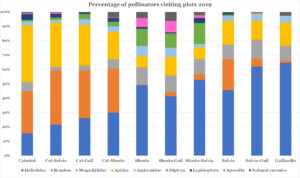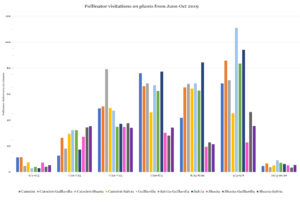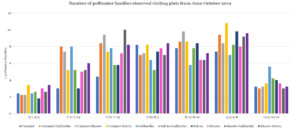Final report for FW18-030
Project Information
Abstract
According to 2015 wild bee maps, key agricultural regions in the Western USA are at risk due to declining native bee populations coupled with a rising demand for crop pollination (Koh et al. 2015). These regions need to increase effective pollination habitat while not alienating farmers. Growers want to encourage pollinators but are hindered by lack of knowledge, limited time and labor, and the perception that pollinator habitat is weedy.
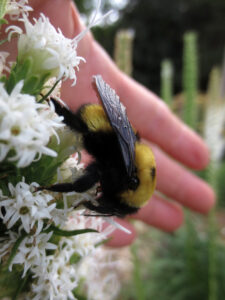
This study has three main goals. First, exploring whether designing pollinator habitat to include plant species with divergent architecture increases native pollinator and beneficial insect diversity and abundance when compared to pollinator habitats containing species with similar architecture. This novel concept will expand research in the field and allow development of more effective multifunctional habitat. Second, evaluating ten economically viable crops, in this case cut flowers, for inclusion in pollinator habitat design based on their ability to attract pollinators and suitability to the Northwest. This will increase grower interest by providing an economic incentive to establish pollinator habitat. Third, encouraging growers to establish more pollinator habitat by developing farmer friendly pollinator plant groupings that are economically profitable, easy to maintain, inexpensive, and non-invasive.
Education and outreach will include local farmers, western growers and pollinator researchers. For local farmers we will have a field tour and presentations on farmer friendly pollinator habitat. To reach out to nonlocal farmers we will develop webpages, an infographic and downloadable pamphlets on creating a habitat for wild pollinators in the Northwest. To further pollinator research we will submit at least one research paper on the effect of diverse plant architecture on native pollinator abundance and diversity.
1) Evaluate if a more diverse plant architecture influences pollinator and beneficial insect abundance and diversity (year 1-2).
2) Evaluate the suitability of ten different pollinator friendly marketable crops (cut flowers) for inclusion in pollinator habit (year 1-2).
3) Develop easy to establish, non-invasive, cost-effective and obtainable pollinator modules for western farmers (year 2).
4) Encourage adaptation of more effective pollinator habitat among local and regional farmers by developing and distributing educational material for growers on sustaining native pollinators (year 2-3).
5) Survey pollinator diversity and abundance on a WA certified organic farm (year 1-2).
6) Write and submit a research paper(s) on study (year 2-3).
Research
This study explores whether designing pollinator habitats to include plant species with divergent architecture will increase pollinator and beneficial insect diversity and abundance when compared to habitats containing plants with similar architecture. Plant architecture is the three-dimensional organization of the plant, including shape, size and position of branches, leaves and flowers. Different plant species can have similar architecture. A habitat diverse in terms of species can be similar in terms of architecture. The experimental design accounts for both species’ diversity and plant architecture. It will be conducted on a small organic farm near Colfax, WA owned by Jane Fluegel. The farm is surrounded by large conventional wheat farms. The area selected for the study is a very uniform, flat fertile field. Land will be prepared by tilling, measuring out plots, and laying down paper mulch and sawdust for weed suppression.
Objectives 1) Evaluate if a more diverse plant architecture effects pollinator and beneficial insect abundance and diversity. To accomplish objectives #1:
- We will use a randomized block experiment with five blocks and ten treatments.
- Treatments are designed to account for both plant diversity and plant architecture. The four selected plants are two pairs of non-invasive, commercially obtainable, pollinator friendly plants for the Northwest. Matched pairs are architecturally similar. The two different pairs are architecturally diverse.
Matched plant pairs:
- Salvia Caradonna (S) with Nepata x faassenii ‘Walker’s Low’ catmint (C)
- Leucanthemum x superbum ‘Alaska’ (L) with Gaillardia ‘Burgundy’ (G)
Diverse plant pairs:
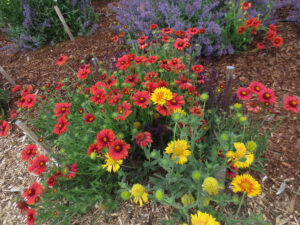
- Salvia Caradonna (S) with Leucanthemum x superbum ‘Alaska (L)
- Salvia Caradonna (S) with Gaillardia ‘Burgundy’ (G)
- Nepata x faassenii ‘Walker’s Low’ catmint (C) with Leucanthemum x superbum ‘Alaska (L)
- Nepata x faassenii ‘Walker’s Low’ catmint (C) with Gaillardia ‘Burgundy’ (G)
In addition, each plant will be evaluated separately.
- Each treatment will have 5 replications.
- Blocks control for time of insect counts. We can record insect visitors in ten plots at once.
- Each plant species will be evaluated 1) separately, 2) with an architecturally similarly paired plant species, and 3) with an architecturally dissimilar species (from the opposing pair). This design will allow us to evaluate whether changes in pollinator diversity and abundance are the result of the individual plant (one species in plot), species diversity (two species in plot with very similar architecture) and/or architectural diversity (two species in plot with widely divergent architecture). The ten treatments will be: SS, CC, LL, GG, SC, LG, SG, LC, SL, and CG.
- Treatments will be a 3 x 2 ft. plot with 6 plants randomly planted 12 inches apart.
- Plots will be covered with paper mulch and bark mulch to allow establishment without weed competition. Growers have enough to do without weeding pollinator strips. Full mulch will be applied in spring to reduce winter kill due to crown rot.
- Pollinator visitation and diversity will be assessed at least six full days for each treatment spaced out from April through August. We will use time lapse video camera surveillance. Edwards et al. (2015) demonstrated the effectiveness of portable time lapse video for pollinator counts.
- Time lapse photography will be scanned and pollinator and beneficial insects will be counted and identified. To conserve pollinators, pollinating insects will be identified in a non-interfering manner through photos. Periodic scouting will allow us to become familiar with regular pollinator visitors and to capture unknown insects for positive identification.
- Plant vigor and growth will be accessed each month during the growing season through foliage area cover and flower numbers. Due to the extreme vigor of the plants, this was done by recording percentage plot coverage and bloom coverage of each plant variety.
- Treatments will be analyzed for significance using ANOVA.
2) Evaluate the suitability of ten different pollinator friendly marketable crops (cut flowers) for inclusion in pollinator habitat. To accomplish objective #2:
We will use a randomized block design with 10 treatments and 3 blocks.
Treatments will be ten economically viable plant species (cut flowers) with three repetitions. Flowers chosen for the secondary study include:

- Achillea millefolium 'Red Velvet'
- Achillea millefolium 'Terra Cotta'
- Campanula glomerate 'Superba'
- Helenium autumnale MARIACHI 'Bandera'
- Echinacea 'Hot Summer'
- Liatris spicata 'Floristan Violet'
- Liatris spicata 'Floristan White'
- Penstemon digitalis 'Husker's Red'
- Salvia nemorosa 'East Friesland'
- Veronica longifolia 'Allord'
- Blocks control for time of insect counts. We can record insect visitors in ten plots at once.
- Plots will be 3 x 2 ft. with 5 plants placed 12 inches apart.
- Paper and bark mulch will be applied in early spring to prevent winterkill through crown rot.
- Pollinator visitation and diversity will be assessed on at least six full days within each treatment spaced from April through August using time lapse video camera surveillance.
- Time lapse photography will be scanned and pollinator and beneficial insects will be counted and identified. To conserve pollinators, most pollinating insects will be identified in a noninterfering manner through photos. Periodic scouting of the treatments will allow net capture of unknown insects for positive identification.
- Plant vigor and growth will be accessed each month from April through August through foliage area cover and flower numbers. Due to the extreme vigor of the plants, this was done by recording percentage plot coverage and bloom coverage of each plant variety.
- Treatments will be analyzed for significance using ANOVA.

3) Develop an easy to establish, non-invasive, cost-effective and obtainable pollinator and beneficial habitat modules for western growers. We will use information from our research, as well as other expert resources, to design pollinator habitat modules specifically for the western US that can easily be used singularly or combined as strips or patches by growers.
4) Survey of pollinator and beneficial diversity and abundance on a Washington certified organic farm. Information we obtain from insect counts will be used to compile a survey of insect diversity and emergence during the growing season.
5) Encourage growers to put in more farmer friendly pollinator and beneficial insect habitat. This will include compiling information, taking plant and insect photos, and creating educational material specifically for growers on sustaining native pollinators and beneficial insects through low care, non-invasive, cost-effective, and economically viable pollination modules.
6) Write research paper on study. Analyze data and write up findings.
Project Update for 2018
Plant selection and care
Criteria
A lot of debate went into plant selection. Jane Fluegel, our horticulture expert, eventually selected a great group of plants. We decided to use only economically valuable cut flowers for the experiment. Our criteria were that all the plant species selected needed to:
- be attractive to diverse native pollinator species
- have a beautiful long-lasting bloom suitable for farmers to sell as cut flowers (some of our choices reflect the growing trend of more 'natural' appearing flower arrangements)
- enjoy a long blooming time
- not be a noxious weed or a problem for local farmers
- have robust growth without an invasive tendency
- be locally available; we didn’t want rare or hard to obtain flowers
- thrive in the Pacific Northwest climate without being babied
Flowers species chosen for the study:
For the main study on the effect of plant architecture on pollinators we paired similar plants:
- Salvia Caradonna (S) with Nepata x faassenii ‘Walker’s Low’ catmint (C)
- Leucanthemum x superbum ‘Alaska’ (L) with Gaillardia ‘Burgundy’ (G)
As described in materials and methods we will test ten variables with five repetitions and four plant species: SS, CC, LL, GG, SC, LG, SG, LC, SL, and CG
Flowers chosen for the secondary study to valuate the suitability of ten different pollinator friendly marketable cut flowers for inclusion in pollinator habit:
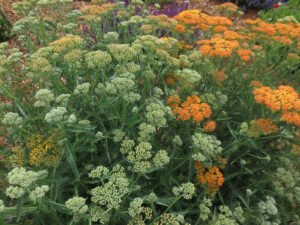
- Achellea millefolium 'Red Velvet'
- Achillea millefolium 'Terra Cotta'
- Campanula glomerate 'Superba'
- Helenium autumnale MARIACHI 'Bandera'
- Echinacea 'Hot Summer'
- Liatris spicata 'Floristan Violet'
- Liatris spicata 'Floristan White'
- Penstemon digitalis 'Husker's Red'
- Salvia nemorosa 'East Friesland'
- Veronica longifolia 'Allord'

We obtained 3.5” potted plants in mid-May. We immediately repotted all the plants in gallon pots using organic potting soil. Plants were cared for and watered during the hottest part of summer in preparation for fall planting. This is where Jane's expertise in nursery plants came in handy. Since we started plants early, we will have large healthy two-year-old plants next year. See the size of our plants in the photo to the right (photo of Susan Fluegel with some of our healthy and beautiful potted plants in summer of 2018).
After selecting our plant species, I realized that I had underestimated the space needed for mature plants of these large robust species. Since the plot size needed to stay small enough to position a camera over the plot and care for plants without stepping into the plot and compacting soil, I consulted Jane and adjusted the number of plants per plot. We reduced the number of plants in each plot to six plants per plot for the main experiment. The reduction in plant number per plot allowed us to use additional plant funds for the supplies and labor needed to repot plants and grow flowers to a gallon size. With this change to much larger plants we will get earlier and larger blooms and more pollinator data the first year.
Field and plot preparation
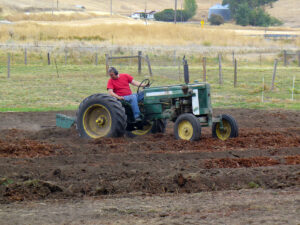
The field area we are using for the study had slightly compacted soil. It was covered with grass, a few Canadian thistle patches and some other hard to kill perennial weeds. From previous experience with defeating these troublesome green foes, we knew that solarization was a great way to control perennial weeds organically.
The plot area was covered with heavy tarps for 2 months in the summer to kill the perennial weeds through solarization. After weeds were killed, the soil was spiked to reduce compaction, plowed, and rototilled using a small 1950’s John Deere tractor.
During tillage the soil was amended with added horse manure and bark mulch to raise organic matter content, add nutrients and improve soil water holding capacity. This step gives plants a great head start. Both the spiking of the soil and the plowing in of amendments took us a little more time than we estimated but the great results were worth it.
The plot area was measured, the plot was squared, and individual plots were marked using 2-foot wooden surveyor stakes. Due to the number of plants we selected per plot, and for ease of drip irrigation installation, the plot size ended up being three feet by two feet.
Experiment planting
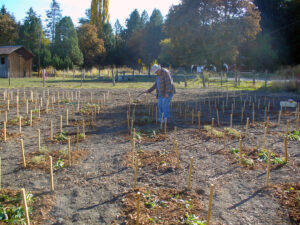
Large, fully rooted gallon-size plants were planted one foot apart in the marked plots in late September 2018. Susan, Jane, and our youngest farmers, Ollie and Annabelle, helped plant. Plants were lightly mulched for winter with bark.
The light mulching was to avoid crown rot caused by excessive winter moisture around the base of new plantings. We wanted to be cautious since this can be a major problem with fall plantings in the Pacific Northwest. Our rainfall is greater in the winter months than the summer months.
All the plots will have organic weed paper placed around the plants and full bark mulch as discussed in the grant placed down in early spring before weeds start to emerge.
Plants had ample time to root before winter dormancy. As of early January 2019, experimental plants look healthy and viable. Any plants that winter kill will be replaced in spring (we purchased a few extra plants for insurance). The replacement plants were left in their pots, heeled into the soil in a sheltered area, and mulched heavily with leaves.

Winter 2019
Luckily a thick snow covered the plants during the extreme cold of early 2019! This photo illustrates the mood perfectly as we waited for summer hoping that our little plants were safe under a blanket of white.
Winterkill is always a possibility with fall planting but an insulating blanket of snow makes it much less likely. Usually it is not the cold that kills or harms plants in winter but the freezing and thawing cycles. Snow cover and/or mulch helps by insulating the ground and preventing wide temperature swings.
Camera mounting: planning, prototypes and execution
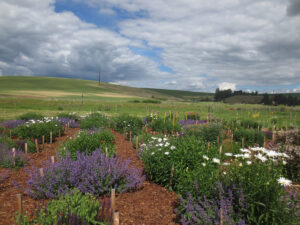
Initial planning winter 2019
Originally, we planned to mount the waterproof time-lapse cameras on permanent fence posts next to the plots. After some discussion we decided to build wooden camera mounts so that the cameras could be mounted above the plot. This would allow for a clearer view of the pollinators on the flowers and more accurate data.
Over the winter we built several prototypes of wooden mounts. They worked well but proved too heavy and ungainly to move easily. This was a problem since my mom and co-researcher, Jane, would have to move the cameras and I didn't want to make it too difficult for her or anyone else moving the cameras. I also wanted something that other farmer/researchers could replicate easily. Chris said he would help us by designing several different working camera prototypes to test.
Working camera mount prototypes spring 2019:
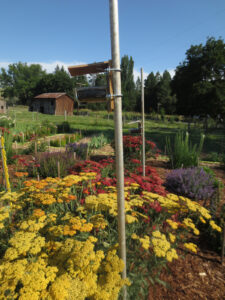
After field testing several camera mounting prototypes, including a lighter wooden frame and a simple step in fence post, Chris Bailey designed a lightweight sturdy camera mount for us. The winning design is shown at left.
These mounts can be made from plastic or metal pipes of any length. Our new camera mount is very light weight which allows us to easily move the mount. The pipe mount pole is stepped into the ground easily with a metal step and a bottom rebar spike. The rebar spike prevents the mount from moving or falling over in strong winds.
We can also easily adjust the camera height from ground level to 6-feet tall. This was essential as the plants grew amazingly well and the camera had to be adjusted on a weekly basis during the spring and summer.
All of us are very happy with the custom made mounts. These camera mounts worked great and stayed upright even in wind or bad weather. Nobody's back got thrown out having to move them either!
In addition, Chris designed a small wooden shade to help protect the camera (which you can see in the upper right). The camera has a water proof case but it was starting to get extremely hot in the sun. The simple shade is held on by clips and helps keep the camera at a reasonable temperature. It does not influence the photos. The cameras can be easily detached from the mount with one step. Afterwards they can be taken out of their waterproof casing to change the batteries and memory cards.
Update 2020:
These camera mounts still work great. When watching the pollinator video it was very obvious when we switched to these mounts. We eliminated the sway in the wind that we had with the first several mount designs. this allowed for easier viewing.
In particular, incorporating a wood cover over the cameras helped protect the cameras from heat and rain. The ten cameras lasted in the harsh weather conditions for over two seasons.
Late winter/early spring 2019
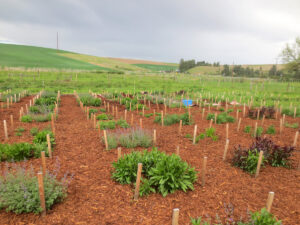
Almost all our plants survived the winter and look happy and healthy. We replaced the few plants that winter killed in the field with potted plants from the same age and batch.
Since the previous 2018/2019 winter was wet we were happy that we delayed mulching until spring. Organic weed paper was placed in all the paths and paths were mulched with several inches of bark. Low flow drip irrigation was installed between plants (3 drips per plot, 1 drip for 2 plants). Plots were mulched lightly.
We have a weather station in the field to record temperature variation, wind speed, solar radiation, humidity and rainfall. Thanks to our weather station we now know that our field has some extreme temperature swings from day to night; sometimes over a 45 °F difference in one day!
In spite of the wide temperature changes (dipping into freezing weather at night and jumping to a balmy 50-60 F during the day), the plants are looking great. The catmint and veronica are out growing the hot weather plants, gaillardia and shasta, at this stage.
Due to some winter kill of the helenium autumnale MARIACHI 'Bandera' we added two catmint 'Walker's Low' to each helenium plot. This made it a mixed plot of helenium and catmint.
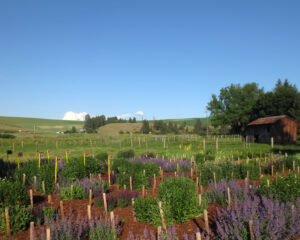
Late spring/summer 2019
Our decision to grow and use larger plants has been an outrageous success. The plants have taken off and are growing like weeds. In addition, planting in fall allowed for successful plant establishment and strong rooting which supported robust spring and summer growth. In areas with milder winters, fall planting will really jump start your perennials. We plan to recommend it as a possible strategy to establishing permanent pollinator plots.
Some of the plants, such as the catmint and veronica, started blooming very early. We had been getting a lot of passerby interest in our pollinator plot but it really started to increase once the plants begin blooming. People were randomly stopping to take photos and ask about the project. We gave quite a few impromptu tours of the pollinator plot and discussed our research.
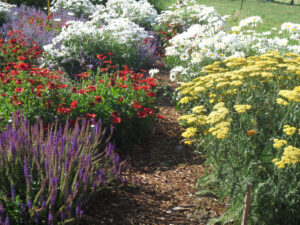
Insect diversity was very high. We attracted both native and non-native insects of all types including bees, flies, moths, butterflies and others. At first it was mainly native bees and other native insects. Later, in midsummer, three different hives of honeybees discovered the plot. We knew they were from different hives due to their different coloration. The honeybees gravitated to the catmint and often totally covered the blossoms.
About midsummer, the noise from the pollinator plot in the middle of the day manifested as a very low key buzzing. It was very peaceful and relaxing. You could stand there and be surrounded by gorgeous flowers and hundreds of busy insects of all sorts. All the bees and wasps were very mellow and nonaggressive.
Plant species influenced insect visitation; although all the flowers were visited throughout the day. You could confidently predict which flowers would attract the majority of some pollinators, however. For example, the catmint attracted more honeybees and large native bees while the shasta's attracted more small native bees and fly species.
Project Update for late winter/summer 2020
This was a very late spring following a cold winter without adequate snow cover. The catmint and salvia thrived and look wonderful. Both plant varieties are huge and the catmint grew like crazy.
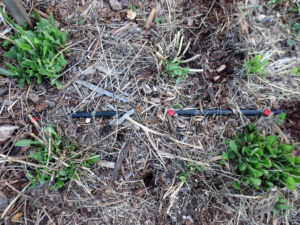
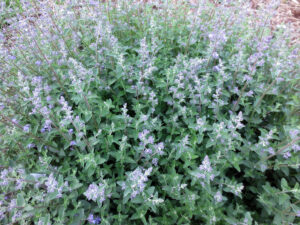
Unfortunately, the gaillardia took a severe hit. In some plots the gaillardia was winter killed and in others it was stunted due to the cold spring. Since the gaillardia was missing or stunted, the other companion pollinator plants muscled into their space. In particular, the catmint took great delight in taking over any and all open space. By the time it got hot enough for the existing gaillardia to grow it was too late for it to compete.
The shasta daisy had the opposite problem, some of the larger plants died back but all the plants reseeded themselves mightily resulting in a virtual sea of spring shasta seedlings. While this would be okay in a pollinator band or wild area, it is less acceptable in a research plot. Even with harsh and swift population control via hand weeding, the shasta overwhelmed the area. Since it reseeded the resulting plants were also less uniform and smaller than the original plants. They also bloomed later in the season due to smaller size.
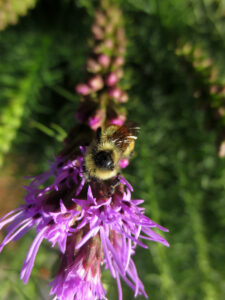
The plots still looked great and attracted attention (socially distanced attention mostly). Some of the plant varieties in our second experiment were spectacular. In particular, the liatris and Red Husker penstemon were gorgeous pollinator magnets. Like the gaillardia, the lavender did not withstand the cold winter. We replaced it with Campanula (bellflowers).
We collected video data all season on all the plots, but due to these two problems could not analyze the second year of the first experiment. We were able to use and analyze the data from the plants in the secondary experiment though and that will be reported.
In early fall, heavy smoke disrupted the pollinators for around a week. We recorded on those days but will not use that data. After that pollinator numbers did not rebound.
Data Collection and Statistical Analysis
Plant time lapse videos were downloaded each day and stored in external hard drives.
We watched videos for each plot to determine pollinator and natural enemy abundance and diversity. For consistency, we watched 30 minutes of video, from noon to 12:30 pm for each plot. Insects were counted using an area 1/4 of the total plot size. In plots with two species of plants, each of the plants were represented in the area chosen for counting.
Video play speed was slowed down and insect numbers were recorded. In addition, each insect was identified according to family (or in some cases superfamily). This identification was made easier since we had spent time during the summer collecting, identifying, and releasing insects. It allowed us to visually identify our regular pollinators on camera later.
Data was recorded.
Statistical analysis
Statistical analysis was done using JASP. Data was analyzed with Repeated Measures ANOVA. Greenhouse-Geisser was used for sphericity correction. Time was the block (repeated measure) in the experiment. Plants were the variable. Data was further analyzed with Post Hoc tests using Tukey. Statistical details will be reported in the published paper.
Charts and Graphs
Charts and graphs were created on Microsoft Excel.
Report 2018
We are just starting our project and do not have results yet.
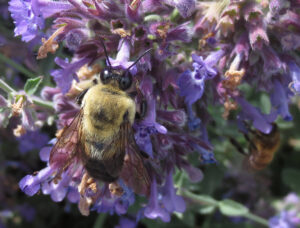
Report 2019
Currently we are analyzing the data for spring 2019 through fall 2019. We have a lot of data to go through so this is our winter project.
We were able to take clear time-lapse videos of pollinators on the plants from early spring to late October and identify the pollinators. Even before analyzing all the data several trends are visible; some plants are much more popular than others, different groups of pollinators have clear plant preferences, and plant diversity in shape and form seems to increase pollinator diversity.
The winner of overall Ms. Popularity is definitely catmint. Catmint is amazing and brings all the native and nonnative pollinators to the yard (either by itself or in combinations with other plants). It blooms from early spring until fall with a short lull midsummer. In particular, the nonnative honeybees love this plant. One time I counted over 60 honeybees on one catmint patch. It makes a very lovely mound of blossoms as well.
However, different groups/insect families of pollinators clearly prefer different pollinator plants and plant combinations. For example, smaller pollinator native bees and flies like the Shasta daisy while the larger bumblebees preferred the catmint, liatris and salvia. Farmers and growers can use some of this information to customize pollinator planting to their crops. We will have some great data on this by the end of the winter.
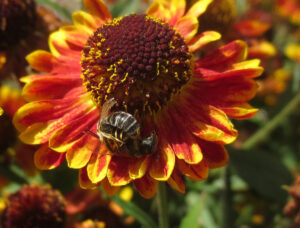
Plant diversity in shape and form seems to have an additive effect on pollinator numbers and diversity. We will know more about this after we finish watching and recording many hours of bee and bug footage.
Overall, the pollinator plants Jane selected are GREAT! They are hardy and beautiful without being fussy or invasive. All are suitable for inclusion in flower bouquets and could be a source of revenue for growers. One of the latest trends in floral designs is increasing the unique texture and color of displays by incorporating more unorthodox blooms, such as traditional garden flowers and bloom sprays instead of single flowers. In addition, locally produced blooms are correctly perceived as more eco friendly due to concerns about the sustainability of cut flower production.
The correct combination of pollinator plants can be depended on to bloom from spring to fall frost. Our flower producers all bloomed at least once and many rebloomed all season.
In October there was a severe and somewhat unseasonal frost which killed most of the blossoms. At the time, pollinators were still visiting the plants. The few plants still blooming received an influx of hungry pollinators the resulted in some epic bee brawls. Some years may see most of the plants blooming into November, however. Having a reliable food source for pollinators could help sustain local populations.
We were very happy with the success of our pollinator plants. All of us are looking forwards to reporting our more detailed research data.

Report 2020
In the second season of growing we had a very cool spring. This was followed by a moderate summer and capped by an infusion of fall wildfire smoke. Pollinators disappeared on the low air quality days. The smoke reduced many of the local bee populations. This resulted in a slightly shorter growing season.
Plants did not come out of dormancy very fast and we lost many of the gaillardia plants to winterkill. In addition, the Shasta daisies responded erratically. Some died while a great number split and reseeded. Due to the uneven plant loss, we were not able to use the data collected in the second summer to evaluated mixed-plant plots. We were still able to evaluate our other plants for pollinator numbers and diversity.
In spite of the weather, the catmint and salvia did great. These are very hardy plants. Many of our other tough plants grew well also.
Final Report 2021
We had five objectives in this experiment.
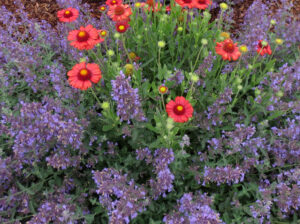
1) Evaluate if a more diverse plant architecture influences pollinator and beneficial insect abundance and diversity.
This was an interesting question that I still want to explore further using a simpler model. The results of our study were a bit inconclusive. I believe it was due to the plant varieties involved in our experiment. Basically, we found that plants paired with other plants of either similar or diverse plant architecture had very similar pollinator visitation numbers. Architecture did not seem to make a difference in pollinator abundance.
However, there were extremely robust pollinator attractions and aversions to two of our main plants, shasta and catmint. This interaction played out in unusual ways in the mixed variety plots. I believe this plant interaction confounded the questions about the effect of plant architecture on pollinators. Plant variety itself significantly influenced pollinator numbers and plant variety significantly influenced pollinator/insect diversity.
We were able to document and analyze a lot of useful data about pollinator attraction to our research plants over the growing season. I am particularly excited about the data on percentage of different pollinator families visiting each plot/plant. This data will be extremely valuable to farmers or researchers who want to put in pollinator plots. It will also add to our knowledge of native pollinator plant preferences. In addition, this useful data on pollinators will make an interesting research paper.
To examine how plant variety influenced pollinator diversity, we looked at two factors; one, the number of pollinator families/groups visiting each plot and two, the percentage of each pollinator family/group visiting each plot. Families/groups were categorized as follows: Bombus species, the bumblebees, were separated from the other Apidae, such as honeybees and other native Apidae bees. Also due to lower numbers, some pollinators were counted using their superfamily or order, such as Diptera (flies), Apocrita (wasps), and Lepidoptera (butterflies and moths). For the same reason, all beneficial insects were listed under natural enemies. Beneficial enemy families counted included Lygaeoidae, Coccinellidae, Raphidioptera, Elateridae, Silphidae, Libellulidae, Chrysopidae, Hemerobiidae, Pentatomidae, Rhopalidae, Reduviidae and Formicidae. Araneae families, which were included under natural enemies also, were Thomisidae and Salticidae. Due to our camera placement, we could only see insects on top of the leaves, so natural predators hiding under leaves were not counted. Due to this, natural enemy count was likely lower than the true number.
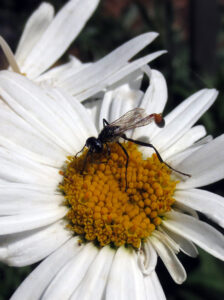
Although shasta had a significantly higher amount of pollinator diversity as measured by family numbers, it also had significantly decreased pollinator visitations. Shasta seems to actively discourage some species of bee pollinators even when combined with other plants. It significantly reduced numbers of bumblebees (Bombus species) and other members of the Apidae family, such as honeybees, when by itself or paired with gaillardia or salvia. Shasta combined with catmint has a muted effect.
Catmint with any of the other plants, including shasta, significantly increased the percentage of Bombus species. It was the only plant in the experiment that mitigated shasta's effect on native bumblebees. Interestingly, catmint by itself attracted less bumblebees than catmint mixed with salvia, gaillardia or shasta. Its presence seemed to amplify the attraction of bumblebees to the plots.
Catmint, by itself or with salvia and gaillardia, attracted the highest percentage of other Apidae, including honeybees and native bees. On the other hand, catmint, by itself or with any of the other plants, significantly lowered the percentage of Halictidae and Megachilidae visitations.
Gaillardia, salvia, and shasta; individually and in combination with each other; attracted a significantly higher proportion of the native bee family, Halictidae. Megachilidae percentages were higher in gaillardia, shasta and salvia in all combinations except when paired with catmint.

Pollinator abundance over the 2019 season
Plant variety significantly influenced pollinator visitation numbers, although there was a lot of overlap. In sheer numbers of pollinators attracted to plants over the season, gaillardia took the lead. Gaillardia visitation numbers were closely followed by catmint, by itself or with salvia or gaillardia, and salvia by itself or with gaillardia. Shasta, by itself or with salvia or gaillardia, attracted significantly less pollinators than any of the other plant combinations. As mentioned above, plants paired with plants of either similar or diverse plant architecture had very similar pollinator visitation numbers. For example, catmint paired with a dissimilar plant, gaillardia, attracted the same number of pollinators as catmint paired with a similar plant, salvia.
As described previously, time-lapse cameras mounted above plants recorded pollinator activity and visitation each day. Pollinators and beneficial insects were counted in 1/4 of each plot for 30 minutes from noon to 12:30 p.m. (the area covered approximately 1.5 pollinator plants). Results from plot repetitions were averaged.
2) Evaluate the suitability of ten different pollinator friendly marketable crops (cut flowers) for inclusion in pollinator habit.
This was a delightful and interesting part of the experiment. We had some plant varieties that ended up being spectacular, especially the veronica. Pictures of all these plants and descriptions of their care can be seen in my booklet: Increase crop yields by managing pollinator and beneficial insect habitat in the Pacific Northwest. Most of the plant varieties were very low care.
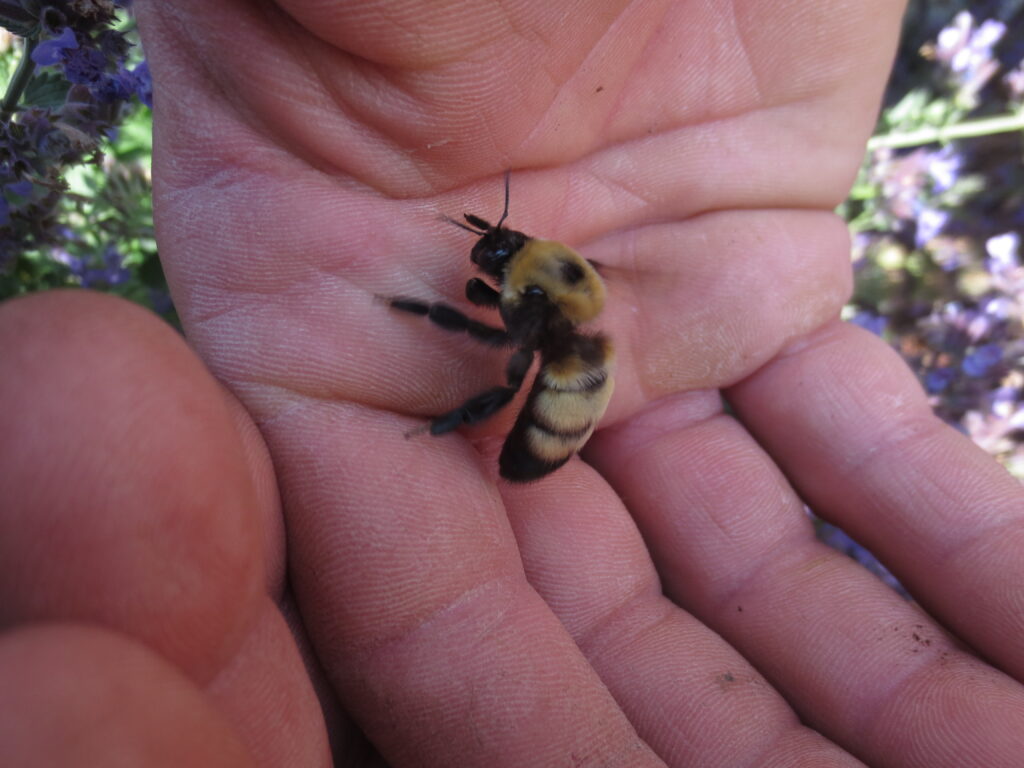
The evaluated plants were
- Achellea millefolium 'Red Velvet'
- Achillea millefolium 'Terra Cotta'
- Campanula glomerate 'Superba'
- Helenium autumnale MARIACHI 'Bandera'
- Echinacea 'Hot Summer'
- Liatris spicata 'Floristan Violet'
- Liatris spicata 'Floristan White'
- Penstemon digitalis 'Husker's Red'
- Salvia nemorosa 'East Friesland'
- Veronica longifolia 'Allord'
Like the main experiment, we also looked at pollinator numbers and pollinator diversity on each plant.
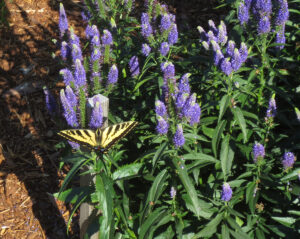
Just as in the main plots, time-lapse cameras mounted above plants recorded pollinator activity and visitation each day. Pollinators and beneficial insects were counted in 1/4 of each plot for 30 minutes from noon to 12:30 p.m. (the area covered approximately 1.5 pollinator plants). Results from plot repetitions were averaged.
Veronica longifolia 'Allord' was significantly higher than other plants in terms of pollinator visitations through the season. It was followed by Campanula glomerate 'Superba' and Helenium autumnale MARIACHI 'Bandera' paired with catmint. If you want an idea of how many pollinators a block of six plants can attract per hour, multiple my count in the chart below by eight! A plot of six 2-3 year old veronica plants attracted approximately 2,200 pollinators per hour midday in late summer. Moreover, the veronica plants were attracting pollinators all day long.
The noon to 12:30 p.m. time period was selected for pollinator counts since it tends to be warmest in the early spring and late fall. However, noon is not usually the busiest pollinator time in the middle of summer (temperature and pollinators tends to peak at 3-5 PM in the middle summer months). Due to this, peak pollinator numbers in the summer months were even higher than shown here.
There was slightly different weather in 2020. It was a much colder spring and summer. Plants were slow to bloom. In addition, heavy smoke from forest fires rolled in fall of 2020. This depleted local pollinators and honeybees and numbers never rebounded. We are not using data from the smoky weeks.
Once again veronica longifolia 'Allord' was significantly higher than other plants in terms of pollinator visitations through the season. It was followed by Campanula glomerate 'Superba'. Achillea millefolium 'Terra Cotta' also performed well.
Helenium autumnale MARIACHI 'Bandera' paired with catmint did not do as well as it did in 2019; but I believe this was due to the fall smoke followed by a very early hard frost. This is a fall blooming plant so the adverse fall weather hindered it.
3) Develop easy to establish, non-invasive, cost-effective and obtainable pollinator modules for western farmers (year 2).
In my booklet Increase crop yields by managing pollinator and beneficial insect habitat in the Pacific Northwest, I discuss different pollinator options and how to create your own pollinator plots. The booklet is included here: Increase crop yields by managing pollinator and beneficial insect habitat in the Pacific Northwest. Most of the plant varieties were very low care. In addition, I discuss which plants attract what pollinator families/orders so you can plant varieties to bring in the native pollinators you want.
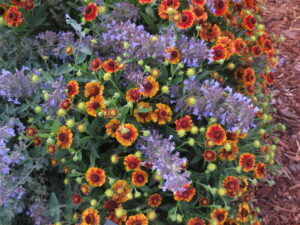
4) Encourage adaptation of more effective pollinator habitat among local and regional farmers by developing and distributing educational material for growers on sustaining native pollinators (year 2-3).
I have given numerous presentations on creating native pollinator habitat, created educational pollinator information for the Rural Roots website, downloaded my booklet on the Rural Roots website and put up several YouTube videos showing pollinator activity (which I plan to expand on). Due to the pandemic, I concentrated efforts on zoom and online education.
I still have a lot of valuable information gained from this study that I plan to continue to add to the Rural Roots website and future pollinator presentation.
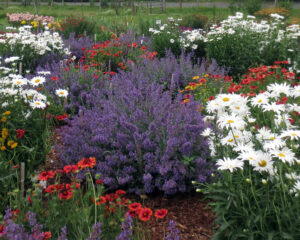
5) Survey pollinator diversity and abundance on a WA certified organic farm (year 1-2).
We now have an interesting map of how pollinator diversity changes over the season on our farm. One surprise to me was the incredible number of native pollinators present on the farm.
I already included some information on pollinator abundance in the report above.
Below is an interesting map showing how pollinator families increase throughout the summer.
6) Write and submit a research paper(s) on study.
I am currently finishing up a research paper for publication on some of our findings for this experiment. All of my statistical analysis will be included in the paper. I will inform WSARE when the paper is accepted for publication.
Research Outcomes
Education and Outreach
Participation Summary:

2018
We are just starting our project so have not reached most of this stage. However, two local large Colfax, WA wheat farmers, one Pullman, WA CSA grower, one WSU facility manager responsible for natural plantings on campus, and a small Colfax, WA organic grower have stopped to ask about our project (and why we have so many stakes in our field) and have been given short tours of the newly planted flowers along with a description of our project. All were interested in increasing pollinators and improving their habitat.
2019
We have given short informal farm tours to 43 people so far including several agricultural professionals. People stop and we offer to give them a tour of the field plot and discuss our research with them.
I have had requests to give two presentations on the pollinator research this spring; one from Rural Roots and one from the Moscow Gardening Society. Several other groups have expressed interest.
We are currently planning our pollinator farm tour for this summer.
I am working on the educational handbooks and our website.
2020-2021
Due to covid-19 and the limitation on gatherings, we had to get creative with our educational component. We were unable to do in person farm tours. To compound problems I needed to isolate from my mother, who is my co-researcher, since she is at increased risk. This also limited our ability to offer personal tours of the pollinator plot although we did do a few masked tours with 1-4 people groups who stopped by and expressed interest.
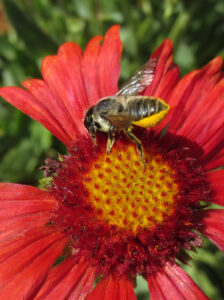
I have approached this problem several ways.
- I currently volunteer on the board of a local non-profit Rural Roots, ruralroots.org, whose mission is education for small farmers, growers and ranchers. While revising the Rural Roots website, I have included a large section on pollinators focusing on native pollinators who often get overlooked. I have also added pollinator plant lists contributed by other local area pollination experts and written many webpages myself.
- I also put up my 36 page pollinator booklet here and on the Rural Roots website: Increase crop yields by managing pollinator and beneficial insect habitat in the Pacific Northwest.
- In 2020 and 2021, I gave several presentations on pollinators and my pollinator study at the Pollinator Summit. In February 2020, I gave an in person presentation at last years Pollinator Summit in Moscow, ID and co-hosted the question and answer section. Over 100 people attended on both days of the two-day Pollinator Summit. This February 2021 I gave a Zoom pollinator presentation at the February Pollinator Summit. I showed some video from my project. We had slightly over 100 people attend the first day and around 80 people attend the second day of the event. I also hoisted one of the breakout groups discussing pollinator habitat on small farms.
- I gave a pollinator and WSARE grant presentation for the Rural Roots monthly Webinar Seminar earlier in February 2020.
- In March 2021 I gave a presentation on the results of my pollinator research and detailed how to create your own pollinator habitat for the UI/Rural Roots Cultivating Success lunchtime seminar series.
- I started a YouTube channel at Working Gloves Farms (one of our farm names). Currently I have a video up showing the amazing pollinators I filmed on my research plots. Over the summer, I plan to add more videos.
- I am working on the research paper to report my results. I will report when it gets published.
Education and Outreach Outcomes
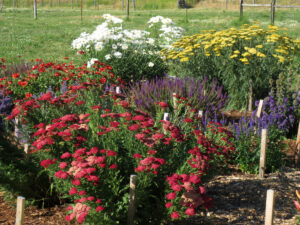
Part of our success the first year was planting larger more established plants that ended up with numerous blooms by mid season. Pollinators were attracted to the flower mecca. This strategy also attracted more human attention due to the sheer breathtaking beauty of a large plot of blooming plants in the middle of a field.
Our willingness to experiment and develop prototypes for camera mounts also contributed to developing a very easy to use mount that can be adapted and used in other research projects.
Going out and interacting with people who stop to admire our pollinator plot has resulted in many people learning about our research and helps us spread information. Talking about the research is an important step of doing the research. We make sure that people know what we are looking at and that it is just not a pretty flower garden (although it is breathtaking!)
I believe the most important thing I have learned is: if you find out that something is not going to work; don't be afraid to change your research protocol. If something is not working, it is better to learn from it and move on. I am noting down my changes to my design because I hope that they can help other farmers/researchers with their research. One example of this, is the changes Chris Bailey made to the posts holding the cameras. Some simple changes made a vastly superior post and saved us a lot of time and effect.
Part of my success in the second and third years of the project is banding with other groups, such as Rural Roots, to present pollinator education. This immersed people in a wider field of knowledge and has resulted in more excitement and willingness to change and adapt. I am particularly excited about having a great platform for the pollinator information.
Two years of close observation with thousands of pollinators has been invaluable to me as a researcher. After viewing the videos I came up with several new lines of research to help answer more questions I have about plants and pollinator interaction. In addition, talking with others about my project has given me ideas on ways to improve and streamline my main research ideas.
The number of native pollinators and their importance.
The variety of beautiful native and cultivated plants suitable for pollination.
Insect photography! The use of time-lapse cameras for pollinator research.
The potential to do pollinator research on their farm.
The variety of native pollinators.
The beauty of pollinator plants.
